
I am Kosar Dakhilalian, a recent graduate of a Master’s in Studies in Comparative Literature and Arts from Brock University. I am currently a STAC curatorial assistant at the Centre for Studies in Arts and Culture. In this series of posts, I discuss material culture and the making of meaning through objects.
Latest Post
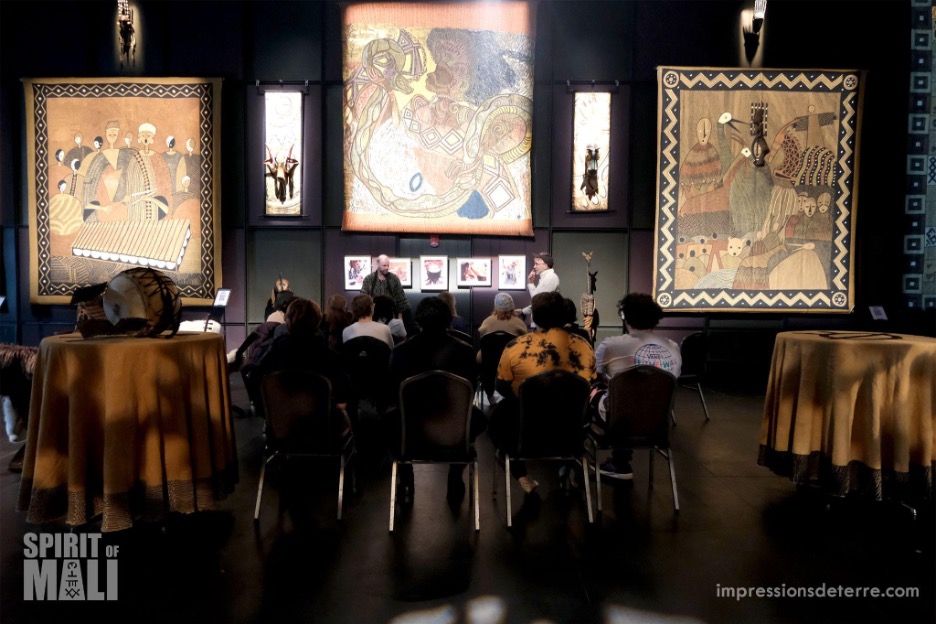
Professor David Vivian, Director of the Centre for Studies in Arts and Culture (STAC) and the students of DART 3F61 Design: Theatrical Design visit Stève Viès and the exhibition. photo: Paul Jams.
In my previous post, I provided some general information about The Spirit of Mali exhibition, including the backstage production and specific events. In this post, I intend to examine the exhibition critically and discuss its importance and contribution.
The Spirit of Mali brought a diverse community together for a celebration of Malian art at the FirstOntario Performing Arts Centre, St. Catharines, from the 1st to the 10th of February, 2023. The exhibition presented textile art, sculpture, puppets, masks, musical instruments, games, and wooden crafts and immersed its audience in the art and culture of Mali. Visitors could enjoy a variety of arts and were welcomed with lectures, individual guidance, live music, dance, food, and an opportunity for socialization in an artistic space. One of the main components of this exhibition was the textiles, some of which are intended to narrate historical and mythological stories which were mentioned in my previous post. Throughout the exhibition, Stève Viès, the curator of this exhibition and a multidisciplinary artist, told the stories upon which the textiles were created. The audience, however, was invited to make their own reading from the works in the exhibition. “Not everyone connects with an artwork the same way”, said Dr. Jean B. Ntakirutimana, a professor in the Department of Modern Languages, Literatures, and Cultures at Brock University, a lead partner in the production of this exhibition. In the round table discussion on February 3rd, Dr. Ntakirutimana shared the profound feeling he had when he entered the space for the first time and talked about one of the objects in the exhibition, the crocodile mask. He stated that the aesthetics of the crocodile which was hung on a piece of white fabric stood out for him initially. He mentions that aside from the symbolism of the crocodile, which represents strength, power, and friendship, one can have their own interpretation when seeing the artifact. He encouraged the viewers to see the artifacts and feel. He added that artworks are stimuli to provoke “vibrations”, and the vibrations are different for each person. He later mentioned that for him, the exhibition connected him with a motherly source.
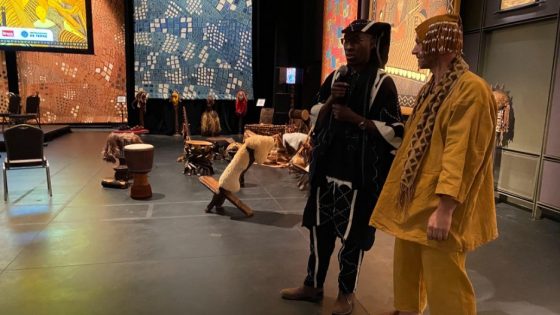
Dr. Jean B. Ntakirutimana (left) and Stève Viès discuss last minute planning before the guided visit and round table discussion. Photo: Paul Jams.
Nafée Faigou, a St. Catharines artist, poet and community leader, the former artistic director of SOFIFRAN, talked about the expression of every component of a work of art, saying the process of making a textile from a plant is “itself a story, which is the story of life”. She continued that “life is not just the matter, but also the spirit”. She mentioned that in this exhibition, the spirit was put into a material space. She stated that the spirit of Bogolan art is fluid and can be described in many ways and may resonate differently for everyone.

Nafée Faigou shares her insight during the roundtable discussion. Photo: Paul Jams.
For me, the exhibition was remarkable in the range of meaning that it offered. It encouraged the personal and symbolic interpretation of the artworks. It provided its audience with information about the artworks but asked them to reflect upon the artworks. What stood out for me in some of the textiles was the use of patterns as a way of coloring some parts of paintings. Some of the patterns, however, symbolized concepts, values, and elements. To me, the patterns seemed like the creation of an intertext in the artwork that connects it with other stories. By providing visual hints to the viewers, they also seemed to be presenting a lens to see the image, suggesting how to interpret the story that the composition depicts. The work, Spiritualité Bambara, for example, depicts an aspect of Bambara culture – the idea of care in a community that is not limited only to humans. A community is formed by interactions between humans and other living entities. In this textile, we see patterns that symbolize marriage, a subtheme for this composition. According to Stève Viès, marriage in Mali culture is not just between two individuals; with the tie of marriage, one becomes responsible for all their new family members. This care and responsibility is not limited to family but can also be seen in the workplace.
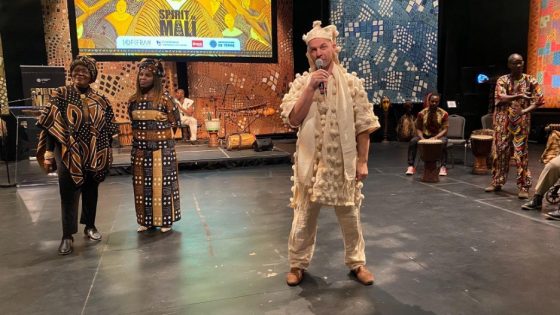
From left, Maman Fété Ngira-Batware Kimpiobi, Justine Djoléi Gogoua and Stève Viès welcome the guests during the opening night ceremonies. Dr. Jean B. Ntakirutimana is seen far right. Photo: Paul Jams.
According to Stève Viès, some of the objects such as masks and puppets presented in the exhibition are used for storytelling in performing arts traditions in Mali. They contribute to the transmission of knowledge in Malian culture. The puppets presented in the exhibition are designed by Torri Diarra for the play The Legend of Bogolan, a musical that was written and performed by Stève Viès and Isabelle Garceau. Torri Diarra has made hundreds of puppets and masks to educate young audiences on the importance of preserving nature, protecting endangered species, and planting trees.
In the opening and closing celebrations of the exhibition on February 4th and 10th, 2023, the audience were immersed in the culture of Mali through music, dance, and food. The organizers of the project from Brock University, Dr. Jean B. Ntakirutimana (Modern Languages, Literatures, and Cultures) and Prof. David Vivian (Centre for Studies in Arts and Culture/Department of Dramatic Arts) engaged the audience in meaningful conversations about the artworks. The group dance exercise was a joyous practice of community building. The celebration ended with notes about collective identity, a sense of belonging, and the importance of the improvement of the self. Community engagement was one of the purposes and outcomes of this exhibition, according to Dr. Ntakirutimana.
“After the closing ceremony”, Dr. Ntakirutimana remarked, “I started feeling a separation like the anxiety a child feels after being weaned.” He referred to Africa as a mother figure for him and the arts presented in the exhibition as the spirit of that continent. The exhibition was a moment for individuals of all ages to see art, appreciate it, discuss it, make connections, dance, and play.

Stève Viès demonstrates a musical instrument in his collection. Photo: Paul Jams.
In order to share the art of Mali with a larger audience, Stève Viès will continue to tour the exhibition and develop a website at impressionsdeterre.com. He presents the art of Mali culture with a “positive vibration” and looks forward to bringing the artists, whom he calls brothers and sisters, to future exhibitions so that they may spark intercultural conversations and knowledge transmission.
Museum in the Hallway / Boîte-en-valise, a project of the Centre for Studies in Arts and Culture, situated on the second floor of the Marilyn I. Walker School of Fine and Performing Arts, continues a small exhibit of art and objects from Mali until the closing reception on March 3, 2023.
Previous Posts
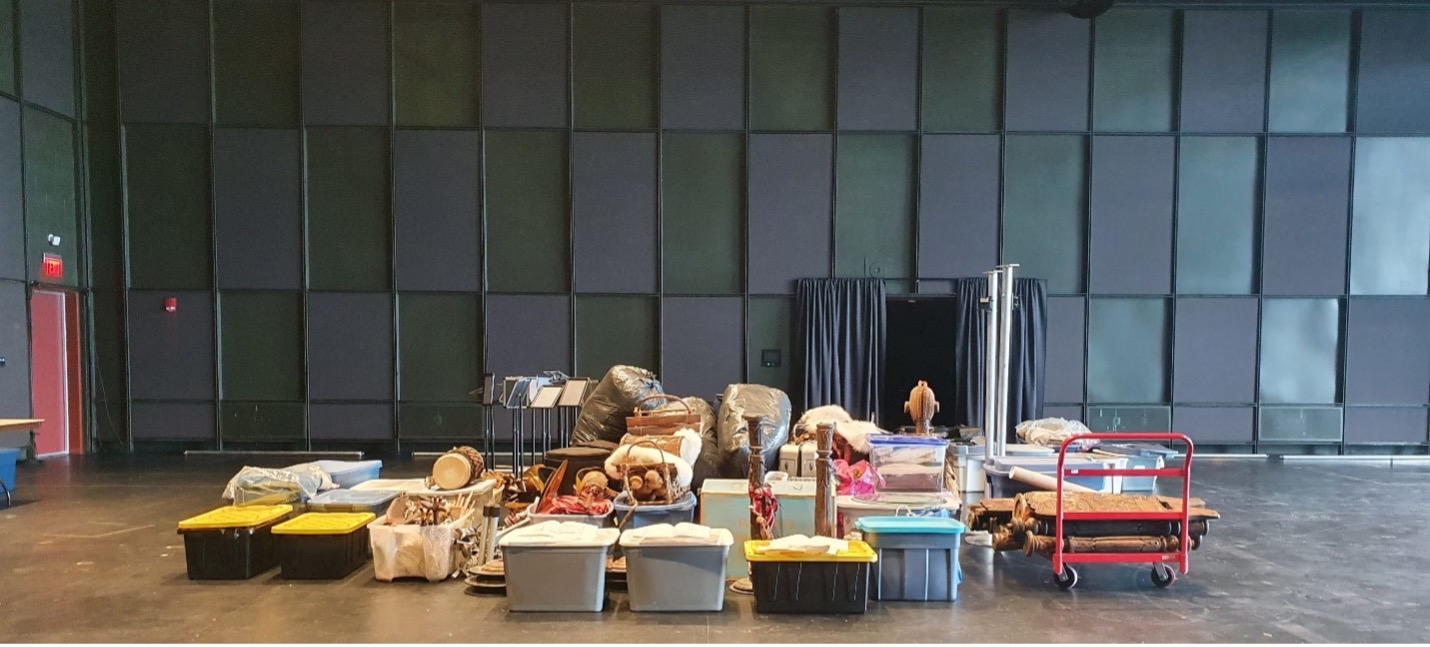
The Spirit of Mali was brought to St. Catharines to celebrate Black History and African Heritage Month. Opening on February 3rd, 2023, in the Robertson Theatre of the FirstOntario Performing Arts Center, the exhibition presents textile art, sculpture, puppets, masks, musical instruments, games, and wooden crafts.
Stève Viès, the curator of this exhibition and a multidisciplinary artist based in Montreal, celebrates and honours the work of the artists and craftsmen Boubacar Doumbia, Mamoudo Nango, Tiorri Diarra, and Abou Konan. The exhibition will provoke excitement and curiosity in its audience, inspire artists with the aesthetic forms practiced in Mali, and spark conversations about different ways that art explores spirituality and brings a community together.
According to Stève, exhibition preparation takes years. The completion of some artworks in the exhibition has taken more than a hundred hours of work. The collection of the objects has required multiple travels to Mali. This exhibition was first planned for February of 2022 but was cancelled due to the COVID-19 risk management policies in place at the time. The installation of the exhibition, alone, took almost 22 hours! Lighting, sound and technical professionals, managers, supervisors, publicity and hospitality teams from the FirstOntario Performing Arts Centre, and students, staff and faculty from Brock University came together to make this event happen.
The process of preparing and installing the exhibition began late on a Sunday evening and soon after the arrival of the collection from Montreal. The first pieces to hang were the large format textiles, some measuring as large as 11’ x 19’. These artworks tell the histories and myths of Soumaoro Kanté, a king of the Sosso people; Sunjata Keita, the first ruler of the Mali Empire; the Battle of Kirina, a battle between the Sosso king Sumanguru Kanté and the Mandinka prince Sundiata Keita. The patterns on the textiles include stories, symbols, and patterns, all painted with natural dyes and colors. The textiles were installed individually and as the background for the masks that would follow. During the guided visits of the exhibition we learn about the important role of these textiles in the presentation of objects like masks and puppets. Proper installation and effective lighting in this non-traditional exhibition space were an important part of the process. The installation planning and coordination was led by Professor David Vivian of the Centre for Studies in Arts and Culture/Department of Dramatic Arts, assisted by students from the Department of Dramatic Arts, staff from the Centre for Studies in Arts and Culture, and myself!
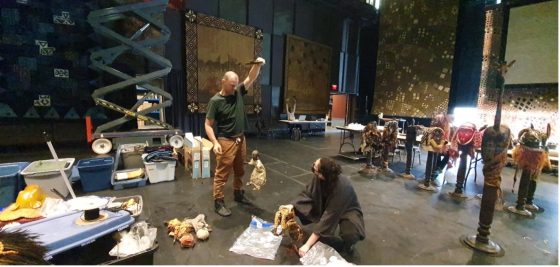 On February 3rd, Stève Viès led us on a guided tour by followed by a mini symposium hosted by Professor Jean Ntakirutimana of the Department of Modern Languages, Literatures and Cultures of Brock University. This was followed by an opening celebration on February 4th, resplendent with dance, musical performance, and discussions in theatre, accompanied by food and beverages from Mali.
On February 3rd, Stève Viès led us on a guided tour by followed by a mini symposium hosted by Professor Jean Ntakirutimana of the Department of Modern Languages, Literatures and Cultures of Brock University. This was followed by an opening celebration on February 4th, resplendent with dance, musical performance, and discussions in theatre, accompanied by food and beverages from Mali.
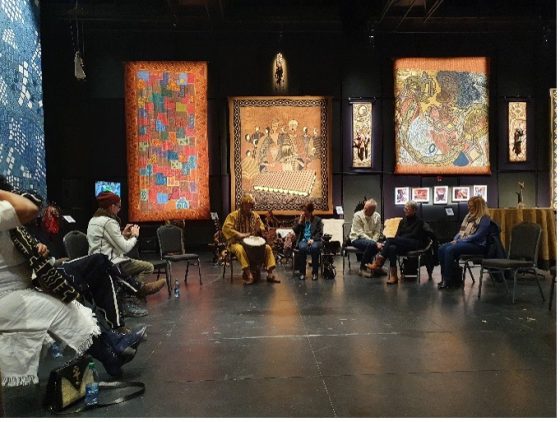
The Spirit of Mali is on exhibition until the 10th of February, with a public celebration on the closing night. Smaller elements are installed at the Marilyn I. Walker School of Fine and Performing Arts as part of the Centre for Studies in Arts and Culture project: Museum in the Hallway / Boîte-en-valise. You may visit this exhibition on the second floor of the MIWSFPA, near the entrances to the MIW Theatre.
In my next posting about the Spirit of Mali I will talk about some of creative and critical responses to the work in the exhibition, and the important work that is done when we invite our community to experience new and remarkable experiences from diverse places and cultures in the world. See you soon!
For more information: https://brocku.ca/miwsfpa/stac/2023/01/16/spirit-of-mali-visits-st-catharines/

This is the first in a series of short postings by the STAC curatorial assistant Kosar Dakhilalian, recently a student of the Master of Arts in Studies in Comparative Literatures and Arts at Brock University. Kosar will introduce you to the backstage and onstage experiences of making meaning in material culture at the Centre for Studies in Arts and Culture.